
How to Have Fun in the Sun According to RCCA’s Dermatologic Oncologists
East Coast residents are no strangers to winter weather, and those long, chilly months tend to make time under the summer sun that much more appealing.
HIPAA Alert: Potential Data Breach Learn More
Questions on Oncology, Hematology and/or Infusion Clinical Services due to COVID-19 Crisis – CALL 833-698-1623
Important Information for Our Patients Regarding the Coronavirus.
RCCA Providing Area Cancer Patients with Access to Care During Coronavirus Outbreak
RCCA Offering Patients Virtual Visits During Coronavirus Pandemic
Cancer can affect anyone from any background. However, some racial and ethnic groups have higher rates of certain kinds of cancer. Regional Cancer Care Associates (RCCA) provides advanced cancer treatment for patients in New Jersey, Connecticut, Massachusetts, and the Washington, D.C., area. Here, we explore some of the most common disparities for cancer by ethnicity and race.

Research shows clear variations in cancer rates and outcomes across different populations in the United States. Genetic factors and socioeconomic background account for some of these differences. Other disparities, particularly in terms of time to diagnosis, therapies administered, and treatment outcomes, are the result of racial inequities in healthcare access, utilization, affordability, and quality of care. Addressing disparities in cancer care is key to improving long-term survival rates and overall public health.
Cancer develops when abnormal cells divide uncontrollably and infiltrate healthy tissues in the body. While anyone can get cancer, factors such as genetics, environment, and lifestyle play a role in an individual’s risk. Racial and ethnic background also can affect risk.
Across all cancer types, there are varying incidence rates among different racial and ethnic groups. These disparities in cancer incidence may be attributed to:
Although cancer mortality rates are decreasing across the board, Black people have the highest cancer mortality rate of all racial groups.
Racial and ethnic disparities have been identified in specific cancer types, including breast, lung, colon, and prostate cancer:
In the U.S., breast cancer rates among Black and Caucasian women are slightly higher than they are among other racial groups. Although white women are more likely to develop breast cancer than other groups, Black women are more likely to develop more aggressive forms of breast cancer and are diagnosed at a younger age. White women are more likely than women of other races to use menopausal hormone therapy, which is linked to a higher risk of breast cancer. Screening rates vary by race, as well; American Indian and Alaska Native women have the lowest screening rates of any racial group.
Lung cancer rates are highest among Black men, even though white men are more likely to be smokers. Survival rates are highest among Asian Americans and Pacific Islanders, and lowest among indigenous communities. On average, patients of color are less likely than white patients to be diagnosed early or receive surgical treatment for lung cancer.
Unlike race and ethnicity, the primary risk factors for colon cancer are controllable: weight, diet, and exercise all affect risk. However, Black people are more likely to develop colorectal cancer and more likely to die from this form of cancer than other racial groups. On a global scale, Jewish people of Eastern European descent (Ashkenazi Jews) have the highest risk of colorectal cancer. Fortunately, regular colon screenings can detect and remove colon polyps before they develop into cancer.
Prostate cancer is one of the most common forms of cancer among men in the U.S. However, Black men are significantly more likely to be diagnosed with and die from prostate cancer than white men. Meanwhile, Asian-American and Hispanic/Latino men have a lower risk than white men. Screening for prostate cancer continues to be a challenge: The American Cancer Society reports that it is not clear if the benefits of prostate cancer screening outweigh the risks.
Genetic mutations that increase the risk of developing cancer can be inherited, and some genetic mutations are more common in specific ethnic or racial groups than in others. For example, a person who inherited the BRCA1 or BRCA2 gene from a parent will have a higher-than-average risk of developing breast cancer. Rates of BRCA1 and BRCA2 variants are higher among people of Ashkenazi Jewish descent than among other ethnic groups. A person’s environment can affect genetic risk, as well: certain environmental factors such as carcinogen exposure can lead to DNA alterations.
Cultural and social norms also can play a role in health behaviors, leading to differences in cancer rates among different populations. For example, in the United States, breastfeeding rates are higher among Asian and white mothers and lower among Black and American Indian/Alaska Native mothers. Not breastfeeding can raise breast cancer risk. Additionally, socioeconomic factors and environmental exposures can increase cancer rates. People of color are more likely to be regularly exposed to carcinogens than white people, a disproportionate impact known as environmental racism.
There are many ways to reduce racial and ethnic disparities in cancer care. Policy changes at the local, state, and federal levels can improve health equity and expand access to quality care. Additionally, providers can integrate culturally competent healthcare practices, such as providing interpreters for people not fluent in English, using community-based health workers, and focusing on outreach and education to affected populations.
Targeted outreach to vulnerable populations may help reduce cancer rates and aid in the early detection of disease. These include:
Supportive care and survivorship programs for patients who have received initial cancer treatment are important for reducing cancer recurrence rates, as well.
As the medical community discovers new advances in cancer diagnosis and treatment, addressing racial disparities in healthcare is crucial. Further research can help us better understand the social determinants of health and how to personalize care for specific populations.
Treating patients at more than 20 locations throughout New Jersey, Connecticut, and the Washington, D.C., area, Regional Cancer Care Associates’ medical oncologists and hematologists are committed to providing comprehensive, compassionate, and personalized care. The experienced medical team at Regional Cancer Care Associates understands cancer risk factors and can treat every type of cancer, as well as blood disorders. To speak with a specialist, request an appointment today.
For more information or to schedule an appointment,
call 844-346-7222. You can also schedule an appointment by calling the RCCA location nearest you.

East Coast residents are no strangers to winter weather, and those long, chilly months tend to make time under the summer sun that much more appealing.

Hematologic oncology is a medical specialty concerned with treating cancers of the blood and blood-forming tissues. Specialists in this field help patients with a variety

A look at who is a candidate for genetic screening, and how that screening should be performed.

Regional Cancer Care Associates is one of fewer than 200 medical practices in the country selected to participate in the Oncology Care Model (OCM); a recent Medicare initiative aimed at improving care coordination and access to and quality of care for Medicare beneficiaries undergoing chemotherapy treatment.